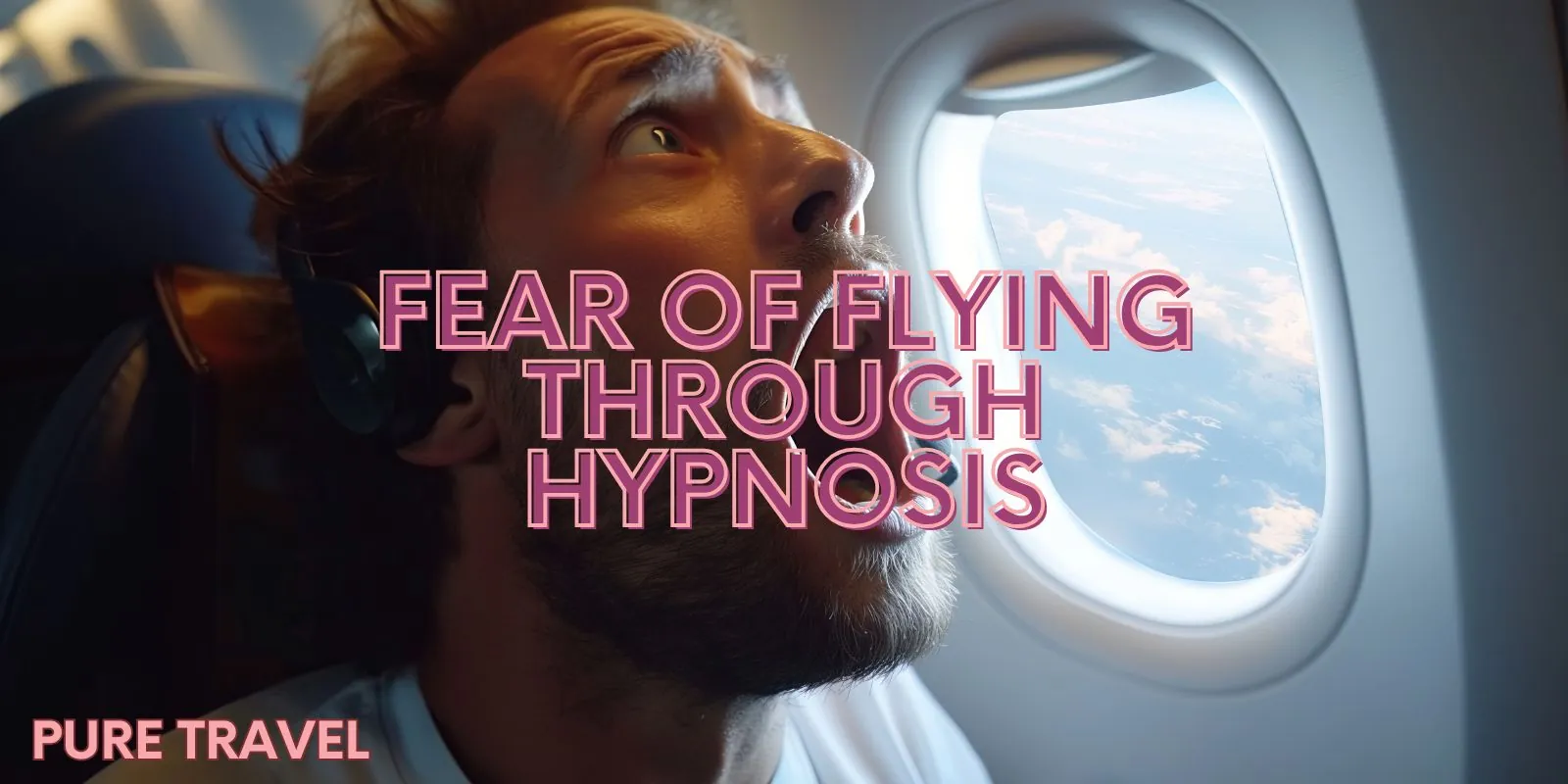Conquer Your Fear Of Flying Through Hypnosis
Fear Of Flying Through Hypnosis – Fear of flying (also called aerophobia or aviophobia) can stop you from seeing the people and places you love. Though flying is statistically one of the safest ways to travel, the intense stress, racing heart, nausea or panic that many people experience is very real and can be deeply limiting.
What is fear of flying?
Fear of flying — sometimes called aerophobia or aviophobia — is an intense, persistent anxiety about being on an airplane. For some people it develops after a frightening flight or accident; for others there’s no obvious trigger. Although rare events (turbulence, technical issues) can provide the initial fright, the lasting phobia often stems from learned associations in the subconscious that hypnotherapy aims to change.
Many sufferers describe feeling trapped, helpless, or out of control when flying — sensations that heighten anxiety. These feelings can be linked to broader fears such as claustrophobia, fear of heights, or a lack of trust in technology and pilots. Over time, avoidance behavior reinforces the fear, making it even stronger. Effective treatment therefore focuses on retraining both the mind and body — helping you break the cycle and reprogram your emotional response to air travel.
Signs that you are facing fear of flying– Fear Of Flying Through Hypnosis
Many people experience symptoms of fear of flying long before they step onto an aircraft. Even the thought of booking a ticket, packing, or seeing planes overhead can trigger tension and discomfort. This anticipatory anxiety often leads to physical reactions such as a tight chest, sweaty palms, or a racing heart — all before the flight even begins. Recognizing these early warning signs is an important first step toward breaking the cycle of fear and seeking support through hypnotherapy or other relaxation-based methods. Symptoms commonly occur before and during travel and can include:
- Acute anxiety or panic at the thought of boarding
- Physical symptoms: shortness of breath, sweating, shaking, racing heart, nausea or dizziness
- Cognitive symptoms: brain fog, catastrophic thinking, an urge to escape the aircraft
- Behavioral avoidance: cancelling trips, using long land routes instead of flying
- Interpersonal impact: missing out on family events or travel plans due to fear
If these symptoms sound familiar, hypnotherapy is one of several evidence-based options that can reduce or remove the phobic response.
Tips to overcome your fear of flying through hypnosis
Hypnotherapy can be a powerful, drug-free solution to ease your anxiety about flying by addressing the fear at its root — your subconscious mind. During hypnosis, your mind enters a calm, focused state where it becomes more receptive to positive suggestions and reframing of fearful associations. This process helps you replace panic and tension with confidence and relaxation.
Hypnosis is a drug-free alternative that helps retrain the subconscious mind. Below are concrete ways it helps:
- Deconditioning of fear responses: Hypnotherapy replaces automatic panic responses with calming suggestions and new associations.
- Controlled exposure in the mind: Guided imagery and visualization allow you to rehearse flights safely and repeatedly until the scenario feels normal rather than threatening.
- Relaxation training: Breathing, progressive muscle relaxation, and focused attention are taught under hypnosis so they become automatic during real flights.
- Identifying root triggers: Skilled therapists help surface earlier memories or beliefs that maintain the fear and reframe them.
- Long-term maintenance: Audio hypnosis or self-hypnosis recordings let you reinforce positive suggestions before and during travel.
Audio hypnosis sessions — how they work
Audio hypnosis sessions are designed to recreate the calming and transformative experience of in-person hypnotherapy from the comfort of your own home. These recordings typically use a soothing voice, gentle background music, and carefully crafted suggestions to guide your mind into a deeply relaxed, focused state. Once in this state, your subconscious becomes more open to new patterns and ideas that help release fear and anxiety around flying. Audio hypnosis is a scalable, convenient option. A typical program includes:
- Intake & assessment: A short interview identifies your specific fears and any prior traumas or triggers.
- Induction & deepening: The recording uses a calm voice and relaxation cues to guide your brain into a receptive state.
- Desensitization & reframing: Through imagery and suggestion, the recording introduces new, non-threatening associations with flying.
- Behavioural suggestions: Practical cues — e.g., slow diaphragmatic breathing, focusing on fixed points, or repeating a calming phrase — are embedded so they’re available during a flight.
- Reinforcement: Repeated listening strengthens the new responses; many people use audio both in the weeks leading up to a flight and during travel.
What to expect from hypnotherapy treatment
Fear Of Flying Through Hypnosis – Treatment timelines vary. Many clients notice reduced anxiety within a few sessions or after consistent use of audio recordings. Expect your therapist to:
- Explain the process and obtain informed consent
- Tailor language and imagery to your beliefs and cultural background
- Teach self‑hypnosis and give a take-home audio when appropriate
- Coordinate with other care (GP or psychologist) if needed
Choosing a qualified hypnotherapist
Look for clinicians who are trained, accredited, and experienced with phobias. Practical tips:
- Check professional association membership and clinical qualifications
- Ask how much experience they have treating fear of flying specifically
- Request testimonials or (where permitted) outcome data
- Confirm whether they use evidence-based methods and give clear aftercare
Self-help strategies to use alongside hypnosis
Pair hypnotherapy with practical self-help for best results:
- Gradual exposure: watch plane videos, visit airports, and sit on short flights as confidence builds.
- Learn breathing and grounding techniques to interrupt panic cycles.
- Use distraction tools: audiobooks, music, or puzzles during flight.
- Bring your audio hypnosis recording to listen to during boarding or turbulence.
- Consider joining flight‑confidence courses or reading trusted articles such as this solo travel piece for travel motivation and practical tips.
When to seek medical or psychological help
Fear Of Flying Through Hypnosis – If your fear is severe — causing panic attacks, avoidance of essential travel, or significant life disruption — consult a medical professional. Hypnotherapy is often used alongside CBT (cognitive behavioural therapy) or medication when appropriate. If you have a history of severe trauma, complex mental health conditions, or suicidal thoughts, contact your GP or a mental health specialist first.
FAQ: Fear Of Flying Through Hypnosis
1. How does hypnosis help with fear of flying?
Hypnosis works by calming the mind and retraining subconscious associations that trigger anxiety. Through guided relaxation and positive suggestion, it replaces fear-based thoughts with calm, confident responses. Over time, flying begins to feel manageable — even relaxing.
2. How many hypnosis sessions are needed to see results?
Many people notice improvements within 2–4 sessions, though lasting change often comes with consistent practice and reinforcement. Audio hypnosis recordings can extend and support progress between sessions or when preparing for an upcoming flight.
3. Can I use audio hypnosis instead of visiting a therapist?
Yes, audio hypnosis programs are a convenient alternative or supplement to in-person therapy. They guide you through relaxation, visualization, and reprogramming steps at your own pace. For complex phobias or past trauma, professional hypnotherapy is still recommended for personalized care.
4. Is hypnosis safe and scientifically supported?
Yes, hypnosis is a safe, evidence-based therapeutic tool used to treat anxiety, phobias, and habits. It’s endorsed by professional medical associations when practiced by trained clinicians. You remain fully aware and in control throughout each session.
5. What if hypnosis doesn’t work for me?
Everyone responds differently. Some experience rapid relief, while others benefit more gradually. Combining hypnosis with complementary methods — such as breathing techniques, CBT, mindfulness, or flight-confidence programs — often enhances long-term success.
Your Sky‑Ready Confidence: Takeoff Awaits
Fear Of Flying Through Hypnosis -Hypnotherapy offers a practical, personalized route to move from avoidance to action. By retraining how your subconscious responds to flight cues and pairing clinical hypnosis with self-help strategies, most people regain control, board with calm, and rediscover the freedom of travel. If you’re ready to explore hypnotherapy, choose a qualified practitioner, try a guided audio program, and give yourself gentle, consistent practice — your next takeoff could feel very different.







